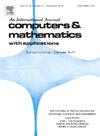Multi-resolution isogeometric analysis – efficient adaptivity utilizing the multi-patch structure
IF 2.9
2区 数学
Q1 MATHEMATICS, APPLIED
引用次数: 0
Abstract
Isogeometric Analysis (IgA) is a spline-based approach to the numerical solution of partial differential equations. The concept of IgA was designed to address two major issues. The first issue is the exact representation of domains generated from Computer-Aided Design (CAD) software. In practice, this can be realized only with multi-patch IgA, often in combination with trimming or similar techniques. The second issue is the realization of high-order discretizations (by increasing the spline degree) with a number of degrees of freedom comparable to low-order methods. High-order methods can deliver their full potential only if the solution to be approximated is sufficiently smooth; otherwise, adaptive methods are required. A zoo of local refinement strategies for splines has been developed in the last decades. Such approaches impede the utilization of recent advances that rely on tensor-product splines, e.g., matrix assembly and preconditioning. We propose a strategy for adaptive IgA that utilizes well-known approaches from the multi-patch IgA toolbox: using tensor-product splines locally, but allow for unstructured patch configurations globally. Our approach moderately increases the number of patches and utilizes different grid sizes for each patch. This allows reusing the existing code bases, recovers the convergence rates of other adaptive approaches, and increases the number of degrees of freedom only marginally. We provide an algorithm for the computation of a global basis and show that it works in any case. Additionally, we give approximation error estimates. Numerical experiments illustrate our results.
多分辨率等几何分析-利用多补丁结构的高效自适应
等距分析(IgA)是一种基于样条的偏微分方程数值解法。IgA 的概念旨在解决两个主要问题。第一个问题是精确表示计算机辅助设计 (CAD) 软件生成的域。在实践中,这只能通过多补丁 IgA 来实现,通常与修剪或类似技术相结合。第二个问题是实现高阶离散化(通过增加样条线度),其自由度数与低阶方法相当。只有当需要近似的解足够平滑时,高阶方法才能充分发挥其潜力;否则,就需要采用自适应方法。在过去的几十年中,已经开发出了一系列针对劈叉的局部细化策略。这些方法阻碍了对依赖于张量乘积劈叉的最新进展的利用,例如矩阵组装和预处理。我们提出的自适应 IgA 策略利用了多补丁 IgA 工具箱中众所周知的方法:局部使用张量乘积样条,但允许全局使用非结构补丁配置。我们的方法适度增加了补丁的数量,并为每个补丁使用了不同的网格尺寸。这样就可以重复使用现有的代码库,恢复其他自适应方法的收敛速度,而且自由度的增加幅度很小。我们提供了一种计算全局基础的算法,并证明它在任何情况下都有效。此外,我们还给出了近似误差估计值。数值实验说明了我们的结果。
本文章由计算机程序翻译,如有差异,请以英文原文为准。
求助全文
约1分钟内获得全文
求助全文
来源期刊

Computers & Mathematics with Applications
工程技术-计算机:跨学科应用
CiteScore
5.10
自引率
10.30%
发文量
396
审稿时长
9.9 weeks
期刊介绍:
Computers & Mathematics with Applications provides a medium of exchange for those engaged in fields contributing to building successful simulations for science and engineering using Partial Differential Equations (PDEs).
 求助内容:
求助内容: 应助结果提醒方式:
应助结果提醒方式:


